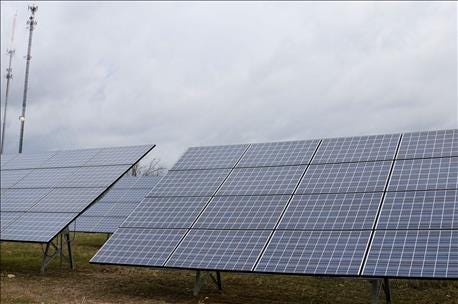
Three different times in the past few weeks I’ve visited farms to do interviews on specific subjects, and come away with a second story about solar energy. In all three cases I didn’t know the farmer had a solar panel system that was generating electricity before I arrived.
Why is there such interest in solar energy? There seem to be several reasons. Here is what we discovered about solar energy so far.
1. Enjoy the thrill of seeing the meter run backwards

PRIVATE POWER SOURCE: Banks of solar panels on farm lots are becoming more common sites in the country.
Exactly how the system is set up determines how energy production is measured. In some instances, when the system is producing energy, the electrical meter that the system is supplying actually runs backward. If it’s what is called ‘net metering,’ the utility basically credits you for what the system produces, and only charges you for the excess of what you use over what you produced. So if the meter is read, it runs backwards at times while electricity is produced, and then runs forward when the system isn’t producing, and it runs forward more than it runs backward, you only pay on the meter reading that is in excess of the previous meter reading.

METER MAGIC: Here’s what you have seen for decades. It’s an electricity meter. As the dial spins and numbers accumulate, you owe the power company money. Now some installing solar power get to see it run backwards, decreasing numbers, as electricity is produced.
2. Get goosebumps over being able to sell electricity to the public power utility
Don and Darci Zolman, Warsaw, installed a bank of solar panels on the office and warehouse location where their farm office is located. Their power supplier is NIPSCO. NIPSCO buys the electricity they produce, and then sells them electricity to operate their facility.
It’s still fun to watch the meter, Don says. When the system is producing, the meter shows all ‘8s’, or an error message. Then when they are using electricity, it shows how much is purchased from the utility.

YOU WON'T SEE THIS ON YOUR METER: The only place you may see all ‘8s’ is when you’re turning on the gas pump at a service station. This meter at Don Zolman’s farm office is showing these numbers because electricity is actually being produced by his bank of solar panels at this time, instead of electricity flowing through from the power company.
3. Electricity grid is now a two-way highway
In some cases electricity can move into the system, instead of always flowing out to be consumed at your location. The only catch is linemen or anyone going to work on the electrical supply lines to your location need to know that electricity could be in the lines even if it is not going into the facility from the utility. It could be coming from the solar panels and into the lines.

A SPECIAL WARNING: You will only find this warning sign where there is an alternate source or power, like solar panels, and there is the possibility of electricity flowing both directions.
About the Author(s)
You May Also Like




